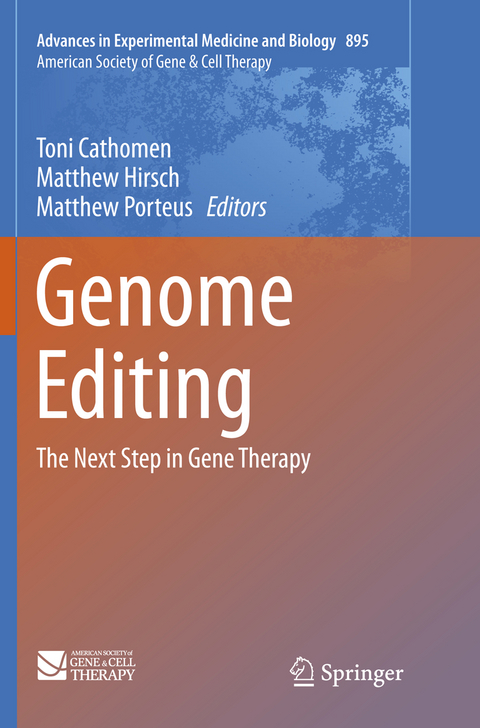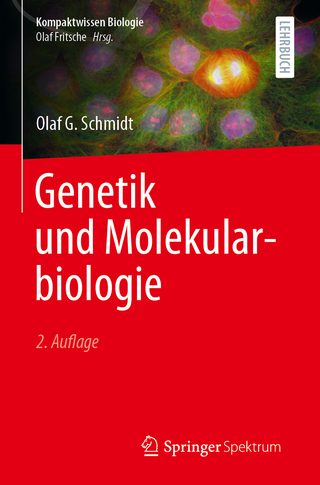
Genome Editing
Springer-Verlag New York Inc.
978-1-4939-8061-1 (ISBN)
Genome Editing: The Next Step in Gene Therapy, the latest volume in the American Society of Gene and Cell Therapy series, deftly illuminates the potential of genetic engineering technology to eradicate today’s deadliest and most prolific diseases. It is ideal reading for clinicians and researchers in genetics and immunology.
Matthew Hirsch, PhD is an Assistant Professor of Ophthalmology at the University of North Carolina (UNC) at Chapel Hill in Chapel Hill, North Carolina. He also holds appointments in Microbiology and Immunology and in Genetics and MolecularBiology, as well as in the Gene Therapy Center at UNC. Dr. Hirsch received his PhD from West Virginia University in Morgantown, WV; his studies focused on E.coli and Salmonella genetics. He completed his post-doctoral research at UNC studying both episomal and chromosomal genetic engineering using adeno-associated virus (AAV). Dr. Hirsch continues these basic AAV studies and has several reagents under preclinical evaluation for the treatment of blindness and muscular dystrophies. Toni Cathomen, PhD is Professor and Director of the Institute for Cell and Gene Therapy at the University Medical Center Freiburg, in Freiburg, Germany. The Institute provides the Medical Center with blood and cell products as well as all transfusion and transplantation related diagnostic services. Dr. Cathomen received his PhD from the University of Zurich, in Zurich, Switzerland. Before his appointment in Freiburg, he was a postdoctoral fellow at the Salk Institute in San Diego, California, USA; Assistant Professor of Molecular Virology at Charité Medical School in Berlin, Germany; and Associate Professor of Experimental Hematology at Hannover Medical School in Hannover, Germany. Dr. Cathomen’s main research goals are to further improve safe genome editing tools (including TALENs, CRISPR/Cas9) for therapeutic applications in human stem cells, to develop disease models and cell therapies based on induced pluripotent stem cells (iPSCs), and to translate cell and gene therapy efforts into the clinic. Dr. Matthew Porteus is an Associate Professor at Stanford Medical School in Stanford, California, and attends clinically at the Lucille Packard Children’s Hospital in Palo Alto, California. Dr.Porteus received a combined MD, PhD from Stanford Medical School. After completing a fellowship with the Boston Children’s Hospital in conjunction with the Dana Farber Cancer Institute, both in Boston, Massachusetts, he did post-doctoral research at both the Massachusetts Institute of Technology in Cambridge, Massachusetts and the California Institute of Technology in Pasadena, California. Following these, he held an independent faculty position at University of Texas- Southwestern in Dallas, Texas in the Departments of Pediatrics and Biochemistry before assuming his current position. In his research, Dr. Porteus focuses on the development of genome editing by homologous recombination as curative therapy for children with genetic diseases. He is also interested in the clonal dynamics of heterogeneous populations and the use of genome editing to better understand pediatric disease, including infant leukemias and muscular genetic disorders.
1. Gene Editing: Double-Strand
Break Induced Gene Targeting and Mutagenesis 20 Years Later.- 2. The
Development and Use of Zinc-Finger Nucleases.- 3.The Use and Development of TAL
Effector Nucleases.- 4. Genome Editing for Neuromuscular Diseases.- 5. Phage
Integrases for Genome Editing.- 6. Precise Genome Modification Using Triplex
Forming Oligonucleotides and Peptide Nucleic Acids.- 7. Genome Editing by
Aptamer-Guided Gene Targeting.- 8. Stimulation of AAV Gene Editing via DSB
Repair.- 9. Engineered Nucleases and Trinucleotide Repeat Diseases.- 10. Using
Engineered Nucleases to Create HIV-Resistant Cells.- 11. Strategies to
Determine Off-Target Effects of Engineered Nucleases.
| Erscheinungsdatum | 26.04.2018 |
|---|---|
| Reihe/Serie | Advances in Experimental Medicine and Biology ; 895 | American Society of Gene & Cell Therapy |
| Zusatzinfo | 43 Illustrations, color; 5 Illustrations, black and white; XVI, 263 p. 48 illus., 43 illus. in color. |
| Verlagsort | New York |
| Sprache | englisch |
| Maße | 155 x 235 mm |
| Themenwelt | Medizin / Pharmazie ► Medizinische Fachgebiete ► Psychiatrie / Psychotherapie |
| Studium ► 2. Studienabschnitt (Klinik) ► Humangenetik | |
| ISBN-10 | 1-4939-8061-0 / 1493980610 |
| ISBN-13 | 978-1-4939-8061-1 / 9781493980611 |
| Zustand | Neuware |
| Haben Sie eine Frage zum Produkt? |
aus dem Bereich


